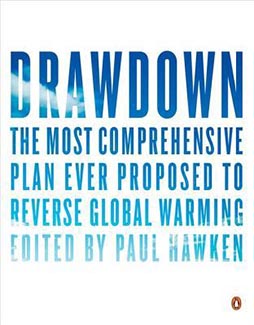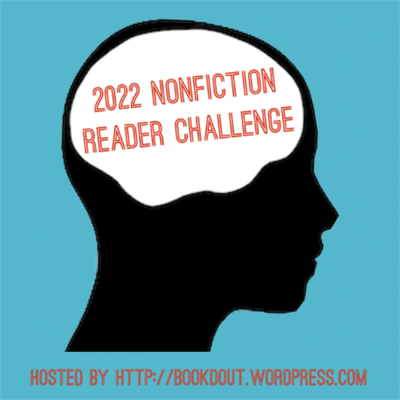I have affiliate relationships with Bookshop.org and Malaprop's Bookstore in beautiful Asheville, NC. I will earn a small commission at no additional cost to you if you purchase merchandise through links on my site. Read more on my affiliate page.

Title: Drawdown: The Most Comprehensive Plan Ever Proposed to Reverse Global Warming
Author: Paul Hawken
Genre: Science
Audience: Adult
My Review:
I needed to read a book about climate change for the Nonfiction Reading Challenge hosted by Shelleyrae at Book’d Out. I didn’t want something that was going to depress me so I decided to read a book focused on solutions rather than problems. Drawdown fit the bill but I still got a little depressed. We know what needs to be done, we have feasible ideas for how to do it, but, at least in the States, we don’t have the political will or impetus to implement many of these solutions. Most of them are only practical at the industrial or national scale. Even ideas that are more personal in scope, like electric cars or solar panels, would be implemented more quickly if we could have better tax breaks or if startup companies had better government subsidies.
The book got a bit too long and detailed for my level of interest. Others will disagree. The editor tried to keep each of the 100 solutions to just a few pages, giving a rough overview of the science, the benefits, and the negatives. I probably had the attention span for about 50 of these solutions. I would recommend buying a copy so that you can dip in and out as your interest and time allow rather than checking it out of the library and trying to finish it all before the due date.
Speaking of negatives, I feel that they were glossed over a bit. I understand that we do need to do something to start addressing the challenges facing us and if we wait around waiting for perfect solutions, we’ll never change anything. But still. It seems negligent not to mention destructive mining practices and battery disposal when talking about electric cars, for example.
Drawdown was published in 2017, which doesn’t seem that long ago in some ways, but technology changes so quickly, parts already feel dated. In the book, Tesla cars seem like an anomaly and their buyers still get a tax break (which I believe is no longer the case). You can’t throw a rock without hitting a Tesla in bigger cities now. But there is an associated website, drawdown.org, that provides updates to the material.
The organization of the book was a bit odd for me. The editor chose to divide the solutions into topics like “Energy” or “Food.” I can follow that. But from there, I don’t know he ordered the solutions in the order he chose. The “Energy” section begins with “Wind Turbines” which he ranks in effectiveness at #2 for onshore turbines and #22 for offshore turbines. Then we went to microgrids, #78, then back to geothermal energy, ranked #18. It was all over the place.
There were a few things that I did really like. The editor devoted one section to cultural changes, specifically related to more feminist topics–women smallholders, family planning, and educating girls. There was a section at the end describing “Coming Attractions”–tech that is in the research and development stage. It might not ever lead to concrete solutions, but I liked taking a peek sort of behind the scenes. Interspersed between the solution essays were excerpts from books that relate to the science of climate change and caring for the planet. For example, there were excerpts from The Hidden Life of Trees by Peter Wohlleben and The Invention of Nature by Andrea Wulf. I really liked these sections and added some of the books to my TBR.
I don’t recommend this for everyone, but if the topic interests you, it’s definitely worth a read. It’s nice to know that we have solutions for climate change. Now if we can only start implementing them on large scales.
Synopsis from GoodReads:
In the face of widespread fear and apathy, an international coalition of researchers, professionals, and scientists have come together to offer a set of realistic and bold solutions to climate change. One hundred techniques and practices are described here—some are well known; some you may have never heard of. They range from clean energy to educating girls in lower-income countries to land use practices that pull carbon out of the air. The solutions exist, are economically viable, and communities throughout the world are currently enacting them with skill and determination. If deployed collectively on a global scale over the next thirty years, they represent a credible path forward, not just to slow the earth’s warming but to reach drawdown, that point in time when greenhouse gases in the atmosphere peak and begin to decline. These measures promise cascading benefits to human health, security, prosperity, and well-being—giving us every reason to see this planetary crisis as an opportunity to create a just and livable world.
Similar Books:
If you liked Drawdown: The Most Comprehensive Plan Ever Proposed to Reverse Global Warming, you might also like my reviews of
- The Invention of Nature: Alexander von Humboldt’s New World by Andrea Wulf
- The Boy Who Harnessed the Wind: Creating Currents of Electricity and Hope by William Kamkwamba and Bryan Mealer
- Fathoms: The World in the Whale by Rebecca Giggs
Reading Challenge:
Purchase:
Buy Drawdown: The Most Comprehensive Plan Ever Proposed to Reverse Global Warming from Malaprop’s Bookstore in beautiful Asheville, NC or







2 Comments
This sounds interesting, but 100 solutions! Goodness. That’s… a LOT. I think this book would be a lot more approachable if it wasn’t quite so comprehensive.
This is such a charged and important topic. It’s a shame this book didn’t quite hit the mark. I haven’t really read anything on the climate crisis and would love to know of a really good, readable book on the topic.